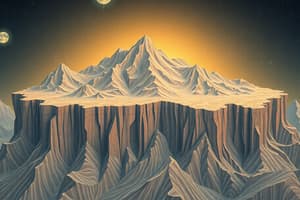Podcast
Questions and Answers
Which type of plate boundary occurs when two plates are moving away from each other?
Which type of plate boundary occurs when two plates are moving away from each other?
- Convergent plate boundary
- Transform plate boundary
- Divergent plate boundary (correct)
- None of the above
What is the term for the area where the edges of two plates meet?
What is the term for the area where the edges of two plates meet?
- Plate boundary
- Plate margin (correct)
- Plate crust
- None of the above
What type of plate boundary involves two plates sliding past each other?
What type of plate boundary involves two plates sliding past each other?
- Convergent plate boundary
- Transform plate boundary (correct)
- Divergent plate boundary
- None of the above
What process occurs along a divergent plate boundary?
What process occurs along a divergent plate boundary?
Which type of plate boundary involves the collision of two plates?
Which type of plate boundary involves the collision of two plates?
Flashcards are hidden until you start studying
Study Notes
Plate Boundaries Overview
- Divergent Boundaries: Occur when two tectonic plates move away from each other, leading to the formation of new oceanic crust.
- Convergent Boundaries: Involve the collision of two tectonic plates, often resulting in subduction, mountain formation, or volcanic activity.
- Transform Boundaries: Characterized by two plates sliding past each other horizontally, causing earthquakes along the fault lines.
Key Terminology
- Plate Boundary: The area where the edges of two tectonic plates meet, critical for understanding geological activities.
- Divergence Process: Along divergent boundaries, magma rises to create new material, forming ocean ridges, rift valleys, or mid-oceanic ridges.
Collision and Interaction
- Types of Collisions: Convergent boundaries result in significant geological structures, including mountain ranges and deep ocean trenches, depending on whether the plates involved are continental or oceanic.
Studying That Suits You
Use AI to generate personalized quizzes and flashcards to suit your learning preferences.




